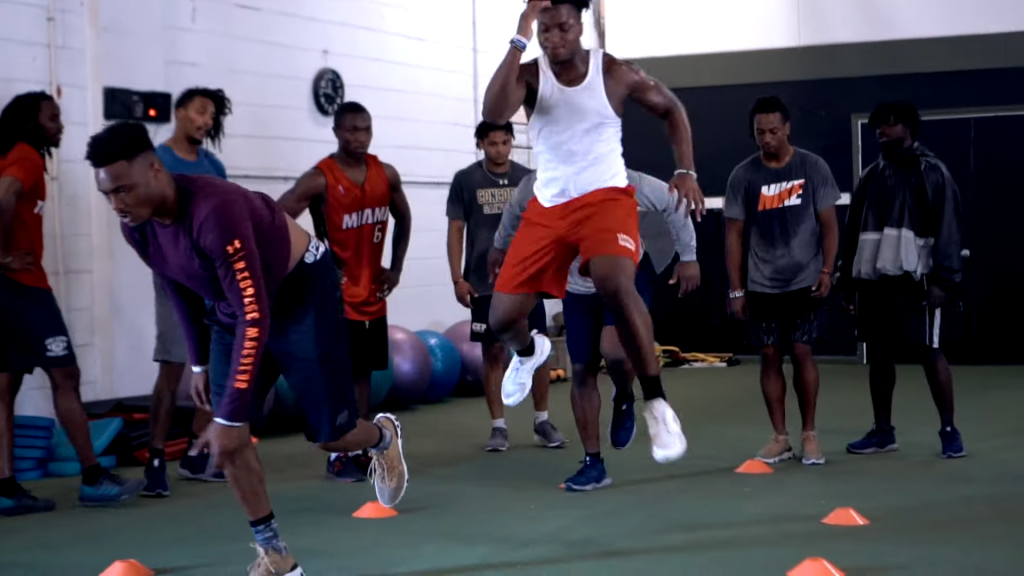Today, I’m here to simplify the complex world of agility training and help you understand how to develop more powerful, agile, and dynamic athletes in your training facility. I’m Chris Barnard, the founder of OTA. Let’s get started.
You’ve probably noticed there’s an abundance of reaction drills, cone patterns, and trendy workouts claiming to enhance agility. But there’s a crucial element missing. You’re implementing various drills with your athletes, expecting automatic improvements in directional changes. Unfortunately, it rarely works that way. Why? Because you’ve overlooked the most crucial aspect: the fundamentals—the basic strength and movement abilities your athletes need to execute effective directional changes.
 Distinguishing Between Change of Direction and True Agility
Distinguishing Between Change of Direction and True Agility
When you talk about change of direction (COD), that’s simply a preset movement: four cones laid out in a square, run to a cone, cut, redirect force. The athlete knows exactly when and where they’re cutting. That’s mechanical, no guessing involved.
True agility, on the other hand, means adding a reaction component. Athletes don’t know when or where they’re cutting until they’re reacting to a stimulus. Whether it’s a coach’s verbal cue, a visual prompt, or the movement of a ball or teammate. That’s decision making under pressure and that’s agility.
Don’t get this wrong: both are important. But they require different tools and progression. Most programs skip COD fundamentals and jump straight into reactive drills which force athletes into scenarios their bodies aren’t ready for.
Why Your Athletes Aren’t Getting Better. Even When They Play the Game
Your athletes may be playing their sport running routes, scrimmaging, practicing drills constantly. Yet they’re not getting sharper in their cuts. They’re not reacting faster. That’s the red flag: despite high sport exposure, they’re not improving.
That’s because they’re missing the physical capacity to perform these movements: strength, force absorption, deceleration, tendon resilience. It’s not always a mechanical or cognitive issue. It’s a physical limitation.
You need to build that foundation. Programs often overlook volume, intensity, and progression. They look for quick, flashy fixes instead. But progress requires strategic scaled stress that increases the athlete’s capacity to handle force in unique directions and reactive patterns.
How We Build Real Agility at OTA
Across ages and levels of youth athletes to pros our agility/change of direction (COD) sessions are heavy on plyometrics. Why? Because leaps, bounds, and controlled landings expose athletes to force redirection at a higher threshold than any cone drill. Here’s how we’ll walk that path:
-
Foundation
Static or low complexity single leg jumps focused on deceleration and landing control. We’re teaching force absorption. -
Isolation
We take foundational cuts say, a 90-degree redirect and compress them into a single jump. For instance: a single leg broad jump followed by a 90-degree cut landing. The athlete experiences high magnitude directional change. -
Reintegration
After isolating these lateral demands, we reintroduce them in sport-based drills. Build the body first, then teach the body to game. -
Progression
We ramp up. From single to multi-continuous jumps, varied planes of movement, added complexity, resistance (medball tosses, partner drives), and manipulated distance or height. At the pro level, we might run single leg triple jumps into 90-degree cuts producing momentum, force, and responsiveness at a game speed load.
Throughout, we assess tissue tolerance of the ankle, knee, hip stability and fix weak links via isolated loading. We layer complexity slowly. We never start at complexity level five. We build the layers of force, stability, cognition through structured plyometric progression.
Get the Most Bang for Your Coaching Buck
You’ve got a 3–4 month off-season training window so how do you maximize it? Simple: elevate physical thresholds FAST. You don’t need endless cone drills. You need stress, isolation, progression.
Your athletes don’t just need to learn how to cut. They need to have the physical capacity to make it precise, fast, stable, explosive. If you dial into these prerequisites: strength, deceleration, proprioception you’ll give your athletes crisp, controllable, powerful cuts that translate straight into performance on the field, court, or wherever.
A Message to Gym Owners and Performance Coaches
If you want your gym to stand out, offer structured progressions. Not fluff. Showcase foundational plyometric training layered into agility programming. Measure athlete changes. Show real athletic outcomes: cleaner cuts, faster reaction, stronger joints.
Educate your athletes and their parents: agility isn’t just a reaction drill, it’s a physical demand that must be trained. If they understand why you’re doing single leg broad jumps into cuts before sprint drills, they’ll value your coaching more and renew their memberships longer.
Wrapping It Up—The OTA Way
-
Don’t skip COD—it’s where you should start.
-
Isolate before you integrate—stress isolated cuts through plyometric progressions.
-
Progress from static to high load & complexity—build capacity before forcing complexity.
-
Finish sessions with COD/agility drills—give them a chance to express what they built.
-
Show, measure, and repeat—transparency breeds trust and renewals.
Gym owners: charge for the value of structured training, more than just drills. Programming agility the OTA way delivers results and sets your gym apart.
That’s it for today. Keep building strong foundations and turning athletes into high performance machines.
– Coach Chris Barnard


1 Response to "The Truth About Agility Training: A Gym Owner’s Playbook"
a